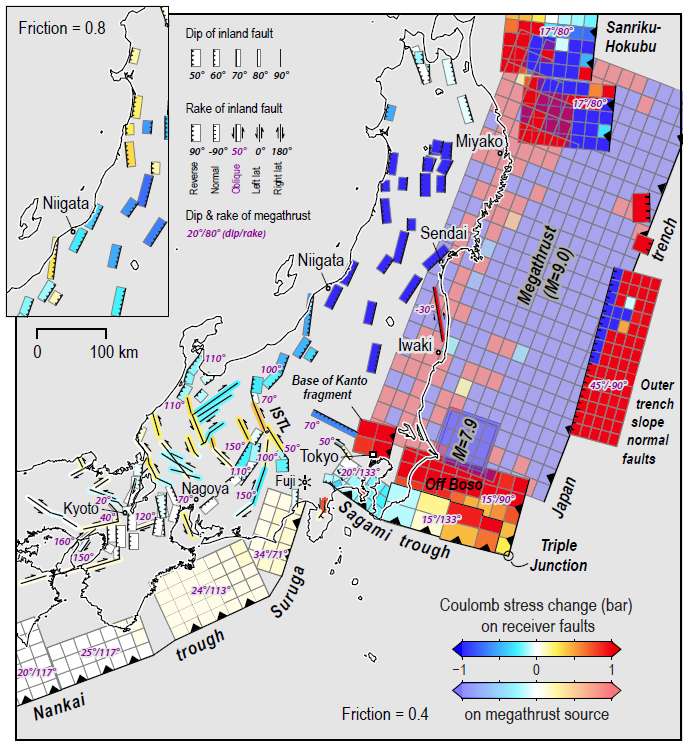The M9.0 megathrust Tohoku earthquake increased stress and brought faults near Tokyo and the damaged Fukushima Daiichi nuclear power plants closer to failure. Moreover, faults far offshore of Fukushima that could generate a major tsunami were also stressed and brought closer to failure by the Tohoku earthquake. According to a report accepted for publication in the journal Earth, Planets and Space by highly respected seismologists:
large sections of the Japan trench megathrust, outer trench slope normal faults, the Kanto fragment beneath Tokyo, and the Itoigawa-Shizuoka Tectonic Line, were also brought ≥0.3 bars closer to failure.
The general public and many scientists have been led to believe that a great earthquake like the Tohoku earthquake relieves stress. In fact, while stress is generally relieved where in the region of fault slippage, adjacent faults may receive stress and be moved closer to failure.
In their plain English summary the authors explain how a great earthquake can trigger more large earthquakes:
Most seismologists assume that once a major earthquake and its expected aftershocks do their damage, the fault will remain quiet until stresses in Earth’s crust have time to rebuild, typically over hundreds or thousands of years. But research over the past two decades has shown that earthquakes interact in ways never before imagined. A major shock does relieves stress—and thus the likelihood of a second major tremor—but only in some areas. The probability of a succeeding earthquake adjacent to the section of the fault that ruptured or on a nearby but different fault can jump by as much as a factor of ten. (diarist's bold)At the heart of this hypothesis - known as Coulomb stress triggering - is the realization that faults are responsive to subtle stresses they acquire as neighboring faults shift, deforming the Earth’s crust. Drawing on records of past tremors and novel calculations of fault behavior, stress relieved during an earthquake does not simply dissipate; instead it moves down the fault and concentrates in sites nearby, promoting subsequent tremors. Indeed, studies of about two dozen faults since 1992 have convinced many of us that aftershocks can be triggered even when the stress is increased by as little as one-tenth the pressure required to inflate a car tire, or about 0.3 bar. While the frequency of aftershocks decays rapidly with time after the mainshock, their magnitude does not decay at all, and so large late aftershocks are an unexpected consequence of a great earthquake.
A separate group of seismologists who calculated the seismic slip to be over 30 meters (about 100 feet) in an area close to the Japan trench showed that a large area of the subduction zone in the earthquake affected area had small amounts of slip. Stress built up over hundreds of years of relative inactivity on the megathrust has been only partially relieved. This figure shows a large number of aftershocks in the fault segments adjacent to the areas of high offset. It shows that the great earthquake triggered aftershocks in the regions where offsets were small or zero. Foreshocks are indicated by blue circles, aftershocks by red circles.
The disturbing implication of these research reports is that
1. A segment of the megathrust fault under Tokyo been brought significantly closer to failure. A major earthquake on this fault segment would directly affect millions of people in the Tokyo region.
2. A left lateral strike slip fault adjacent to the disabled Fukushima nuclear power plants has been stressed. An earthquake on this fault could further damage the spent fuel pools in reactors 4, 5 and 6.
3. A large tsunami could be generated on an area offshore of the trench which has been stressed by the Tohoku earthquake. An normal fault type earthquake occurred in the early 20th century on the northern area, causing an enormous tsunami. A similar earthquake might be triggered in the area far offshore of Fukushima, causing a large tsunami.
The authors of the report in print conclude:
With this test as confirmation, we use the best-performing model and best value of friction to calculate the stress transferred to all major faults that surround the mainshock. We find that large sections of the Japan trench megathrust to the north of the mainshock (the offshore ‘Sanriku-Hokobu’ region 200 km northeast of Sendai), and to the south of the mainshock (the ‘Off-Boso’ region 100 km east of Tokyo), were also brought ≥0.3 bars closer to failure. East of the megathrust, tensional (‘outer rise normal’) faults are bought 1-15 bars closer to failure; large earthquakes on these could trigger a tsunami. The‘Kanto fragment’ that we believe is wedged 50-70 km beneath Tokyo, and the Itoigawa- Shizuoka Tectonic Line (‘ISTL’) 100 km west of Tokyo, were also brought ≥ 0.3 bars closer to failure. Based on our other studies, these stress increases are large enough to increase the likelihood of triggering significant aftershocks or subsequent mainshocks.

